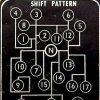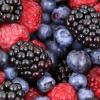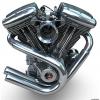
David Sinclair strikes again
#181
Posted 01 March 2014 - 03:37 AM
Yes. One would have to eat a lot of aroma berries, and often !
Quote : " Results
After oral administration peak concentrations of anthocyanins occurred within 30 min after administration. Levels were highest in the urine and gi mucosa. In the gi mucosa and liver the predominant flavonoid species after oral administration was C3G, whilst after iv dosing the majority of anthocyanins was C3G metabolites. After oral or iv administration, C3G half-lives in the different biofluids and tissues ranged from 0.7 to 1.8 h and 0.3 to 0.7 h, respectively. Systemic bioavailabilities for parent C3G and total anthocyanins were 1.7 and 3.3%, respectively. The major metabolites of C3G were products of methylation and glucuronidation. Cyanidin was a minor metabolite in the gut."
http://link.springer...0280-009-0996-7
Maybe Apigenin or quercetin would be better? Interestingly enough David Sinclair is one of the authors in this study
" In addition, we characterize two CD38 inhibitors: quercetin and apigenin. We show that pharmacological inhibition of CD38 results in higher intracellular NAD+ levels and that treatment of cell cultures with apigenin decreases global acetylation as well as the acetylation of p53 and RelA-p65. Finally, apigenin administration to obese mice increases NAD+ levels, decreases global protein acetylation, and improves several aspects of glucose and lipid homeostasis."
http://diabetes.diab...62/4/1084.short
#182
Posted 01 March 2014 - 04:33 AM
#183
Posted 01 March 2014 - 04:42 AM
Several flavonoids, luteolinidin, kuromanin and luteolin also are CD38 inhibitors:Maybe Apigenin or quercetin would be better? Interestingly enough David Sinclair is one of the authors in this study
" In addition, we characterize two CD38 inhibitors: quercetin and apigenin. We show that pharmacological inhibition of CD38 results in higher intracellular NAD+ levels and that treatment of cell cultures with apigenin decreases global acetylation as well as the acetylation of p53 and RelA-p65. Finally, apigenin administration to obese mice increases NAD+ levels, decreases global protein acetylation, and improves several aspects of glucose and lipid homeostasis."
http://diabetes.diab...62/4/1084.short
http://www.ncbi.nlm....pubmed/21641214
This sheds some light on the strategy of combining resveratrol and quercetin, for example, here:Bioorg Med Chem Lett. 2011 Jul 1;21(13):3939-42. doi: 10.1016/j.bmcl.2011.05.022. Epub 2011 May 14.
Flavonoids as inhibitors of human CD38.
Kellenberger E1, Kuhn I, Schuber F, Muller-Steffner H.
Author information
Abstract
CD38 is a multifunctional enzyme which is ubiquitously distributed in mammalian tissues. It is involved in the conversion of NAD(P)(+) into cyclic ADP-ribose, NAADP(+) and ADP-ribose and the role of these metabolites in multiple Ca(2+) signaling pathways makes CD38 a novel potential pharmacological target. The dire paucity of CD38 inhibitors, however, renders the search for new molecular tools highly desirable. We report that human CD38 is inhibited at low micromolar concentrations by flavonoids such as luteolinidin, kuromanin and luteolin (IC(50) <10 μM). Docking studies provide some clues on the mode of interaction of these molecules with the active site of CD38.
http://www.ncbi.nlm....pubmed/24319627
J Clin Exp Cardiolog. 2013 Mar 2;4(3). pii: 238.
Nutritional Supplement-5 with a Combination of Proteasome Inhibitors (Resveratrol, Quercetin, δ-Tocotrienol) Modulate Age-Associated Biomarkers and Cardiovascular Lipid Parameters in Human Subjects.
Qureshi AA1, Khan DA, Mahjabeen W, Papasian CJ, Qureshi N.
To use an economics metaphor, it enhances the "supply side" through activation of mitochondrial complex I, and suppresses the "demand side" through inhibition of CD38.
http://www.ncbi.nlm....pubmed/24178296
Edited by cudBwrong, 01 March 2014 - 04:43 AM.
#184
Posted 01 March 2014 - 11:54 AM
So, this suggests the trick would be to get plasma C3G to around 2-3 μM and maintain it there all day long. The oral pharmacokinetics remain a big obstacle.
Darryl
How much C3G does it take to get plasma levels of 2-3 μM?
#185
Posted 01 March 2014 - 06:19 PM
We need more bioavailable and more potent compounds before marked CD38 inhibition through diet or oral supplements becomes practical. There are plenty of reasons for including robust amounts of flavonoids in the diet, and mild CD38 inhibition may contribute to the effects seen from high flavonoid diets, but we're just tickling the lower end of the inhibition curve at practical doses of the five (at present) known CD38 inhibitors.
Hopefully last year's higher profile paper on apigenin and quercetin from Sinclair's lab will encourage a drug-discovery group to do a high-throughput drug candidate screen with more food / supplement compounds. To be honest, I wouldn't be surprised if the 2nd / 3rd generation sirtuin "activators" Sinclair's Sirtris discovered actually functioned through CD38 inhibition.
#186
Posted 01 March 2014 - 07:13 PM
( I'm trying to do that with supplements and diet )
" Bioavailability of Apigenin from Apiin-Rich Parsley in Humans "
http://www.karger.co.../Abstract/90736
LEF's cruciferous vegetable extract includes 25 mg of apigenin.
http://www.swansonvi...rid=1106610708. provides 50 mg
It's probably not practical or possible to ingest a sufficient amount of flavonoids thru diet alone
http://www.sciencedi...278691599000794
#187
Posted 01 March 2014 - 07:54 PM
At present, significant CD38 inhibition with flavonoids isn't very practical, as absorption is low and metabolism/excretion rather fast. Kay 2004 suggests huge (5-fold) variability between subjects, with doses on the order of 2600-13000 mg of diverse cyanidin-3-glycosides from aronia/chokeberry required to achieve total serum peaks of 2 μM. See also Denev et al 2012.
We need more bioavailable and more potent compounds before marked CD38 inhibition through diet or oral supplements becomes practical. There are plenty of reasons for including robust amounts of flavonoids in the diet, and mild CD38 inhibition may contribute to the effects seen from high flavonoid diets, but we're just tickling the lower end of the inhibition curve at practical doses of the five (at present) known CD38 inhibitors.
Hopefully last year's higher profile paper on apigenin and quercetin from Sinclair's lab will encourage a drug-discovery group to do a high-throughput drug candidate screen with more food / supplement compounds. To be honest, I wouldn't be surprised if the 2nd / 3rd generation sirtuin "activators" Sinclair's Sirtris discovered actually functioned through CD38 inhibition.
Thanks Darryl.
So, assuming that a single teaspoon (5 g) of dried, black aronia berries provides ~400 mg of cyanidin-3-glycosides (according to Timar’s post earlier this thread) it would take between 7 and 32 teaspoons (35 -160 g) to achieve the serum peak of 2 μM. It’s not that much aronia, however you’ll achieve that level only transiently, due to its half-life. Better than nothing, but probably too little to perceive any measurable effects, even with repeated doses.
#188
Posted 01 March 2014 - 08:12 PM
Darryl makes a very good point that we have to look at the size of the effects. I'm not sure that flavonoids will be practical, because of bioavailability issues, but let's look at one that was studied in the Sinclair paper, quercetin. They report:At present, significant CD38 inhibition with flavonoids isn't very practical, as absorption is low and metabolism/excretion rather fast. Kay 2004 suggests huge (5-fold) variability between subjects, with doses on the order of 2600-13000 mg of diverse cyanidin-3-glycosides from aronia/chokeberry required to achieve total serum peaks of 2 μM. See also Denev et al 2012.
So what kind of concentrations are realistic in humans? In this study:The effect of apigenin and quercetin on CD38 activity in vitro was studied using the soluble ectodomain of human CD38 (17). We found that apigenin (Fig. 3A) inhibits in vitro CD38 activity with a half-maximal inhibitory concentration (IC50) of 10.3 ± 2.4 μmol/L for the NAD+ase activity and an IC50 of 12.8 ± 1.6 μmol/L for the ADP-ribosyl-cyclase activity (Fig. 3B and C). In vitro, quercetin (Fig. 3D) inhibits CD38 NAD+ase activity with an IC50 of 13.8 ± 2.1 μmol/L (Fig. 3E) and ADP-ribosyl-cyclase activity with an IC50 of 15.6 ± 3.5 μmol/L (Fig. 3F).
http://www.ncbi.nlm....pubmed/23094941
they find large variability, as Darryl notes, but not quite as high as the study he cites. Looking at different systems (energy bars, water plus Tang, etc.) the means are about one to three micro-moles per litre, converting at Quercetin's molar mass of about 302 grams per mole. (Did I do this correctly?) So it's not wildly out of the ballpark, compared with the Escande / Sinclair et. al. paper's finding of an IC50 of 13.8.
Also, this is without any real bioavailability enhancers for the quercetin. Encapsulation might have an effect. I haven't seen a report on bioavailability of quercetin with piperine, but I wonder if that would also have an effect. Here is the abstract from the study on bioavailability of quercetin in humans:
J Food Sci. 2012 Nov;77(11):H231-8. doi: 10.1111/j.1750-3841.2012.02934.x. Epub 2012 Oct 24.
Comparison of quercetin pharmacokinetics following oral supplementation in humans.
Kaushik D1, O'Fallon K, Clarkson PM, Dunne CP, Conca KR, Michniak-Kohn B.
Author informationAbstract
- 1Ernest Mario School of Pharmacy, Rutgers-The State University of New Jersey, 145 Bevier Road, Life Sciences Bldg, Piscataway, NJ 08854, USA.
The objective of the study was to investigate the absorption of quercetin aglycone in 18 healthy human subjects administered via the following oral carrier systems: suspension of quercetin (quercetin QU995 powder in Tang(®) and spring water), nutritional bars (First Strike™), and chews (RealFX™ Q-Plus™). Subjects were divided into 3 groups of 6 individuals each receiving 500 mg quercetin in one of the aforementioned formulations. Blood levels were monitored immediately pre- and for 32 h postadministration. The concentration of total quercetin in blood samples was determined by solid phase extraction followed by high-performance liquid chromatography analysis. Pharmacokinetic parameters were determined by noncompartmental modeling using Kinetica software. The C(max) of quercetin was highest with RealFX™ Q-Plus™ Chews (1051.9 ± 393.1 μg/L) achieved within 3.3 h as compared to that for First Strike™ Bars (698.1 ± 189.5 μg/L in 2.3 h) and Tang(®) suspension (354.4 ± 87.6 μg/L in 4.7 h). The results showed no statistically significant difference in quercetin absorption among groups due to high variability within groups receiving quercetin from same dosage form. This study represents the first comprehensive evaluation of quercetin absorption from quercetin fortified oral food products at doses commonly used for quercetin supplementation.
PRACTICAL APPLICATION:
The current study describes for the first time, comprehensive evaluation of quercetin PK in humans from quercetin fortified oral food products at doses commonly used for quercetin supplementation. Owing to quercetin's potent antioxidant and anti-inflammatory actions, quercetin is widely being used as a nutritional supplement. In order to maximize the bioavailability of quercetin for its use in efficacy studies, it is important to determine its ideal oral carrier system and route for its delivery. The current research unveils vital information about quercetin supplementation to the international community, especially to soldiers, athletes, and the dietary supplement industry.
#189
Posted 06 March 2014 - 08:04 PM
No Biospan involved here, you get 30 Transmax pills (time release Resveratrol) and 30 MitoTrans (time release NAD+?) 100mg pills for the princely sum of........wait for it.........$479Not yet. They will sell a form mixed with resveratrol
https://www.biotivia..._antiaging.html
I am ordering niagen
Not yet? Yes, you can. Click on the "Reserve now" button.
And it's not mixed with resveratrol. It's a 30 day regimen which includes Transmax and Biospan as seperate products.
Yes, that's one months supply $479!
They reckon you need to take it every 3-4 months....
They deny that it's Nicotinamide Riboside but after doing some digging around strongly suspect it is.
#190
Posted 11 March 2014 - 07:05 AM
United States Application US20140065099 (March 6, 2014) Methods of Treating Mitochondrial Dysfunction
It's past bedtime here, but I plan on scrutinizing this tomorrow.
#191
Posted 11 March 2014 - 07:48 PM
What dosage should I take?Take 2 capsules daily upon waking or immediately prior to consuming first meal. It is not necessary to take NR with a meal. After each bottle we recommend discontinuing usage for 3-5 days for maximum effectiveness.
https://www.mrsupps......47/Niagen N®/
#192
Posted 11 March 2014 - 10:23 PM
Those interested in nicotinamide riboside (and other NAD+ precursors) in conjunction with PARP inhibitors may find the following interesting:
United States Application US20140065099 (March 6, 2014) Methods of Treating Mitochondrial Dysfunction
It's past bedtime here, but I plan on scrutinizing this tomorrow.
Darryl, your posts got me looking into this CD38 inhibition issue. Taking quercetin, apigenin and CG3 each. Was fascinating to find out that it is CD38 that sucks out an insane amount of NAD+ and that CD38 gets expressed broadly by the white cells of the immune system. Sounds like a link between the chronic inflammation brought by aging and, frankly, getting fat and CD38 and then decreased NAD+ levels. Already noticing interesting positive impact on the digestive system and even on athletic performance. Shall see where this takes me. Taking Niacin and NR also. Thanks, Darryl.
Edited by Ukko, 11 March 2014 - 10:24 PM.
#193
Posted 11 March 2014 - 11:01 PM
Darryl, your posts got me looking into this CD38 inhibition issue.
[ ... ]
Thanks, Darryl.
A big thank you to Darryl and everyone who contributed to this interesting thread.
#194
Posted 12 March 2014 - 02:47 AM
Darryl, your posts got me looking into this CD38 inhibition issue.
Thanks, Darryl.
A big thank you to Darryl and everyone who contributed to this interesting thread.
+1.
NAD+ and C60 are the most fascinating themes I have found so far thanks to you guys.
Edited by aribadabar, 12 March 2014 - 02:48 AM.
#195
Posted 12 March 2014 - 04:17 AM
#196
Posted 12 March 2014 - 05:04 AM
Those interested in nicotinamide riboside (and other NAD+ precursors) in conjunction with PARP inhibitors may find the following interesting:
United States Application US20140065099 (March 6, 2014) Methods of Treating Mitochondrial Dysfunction
It's past bedtime here, but I plan on scrutinizing this tomorrow.
Darryl, your posts got me looking into this CD38 inhibition issue. Taking quercetin, apigenin and CG3 each. Was fascinating to find out that it is CD38 that sucks out an insane amount of NAD+ and that CD38 gets expressed broadly by the white cells of the immune system. Sounds like a link between the chronic inflammation brought by aging and, frankly, getting fat and CD38 and then decreased NAD+ levels. Already noticing interesting positive impact on the digestive system and even on athletic performance. Shall see where this takes me. Taking Niacin and NR also. Thanks, Darryl.
Ukko, I remember you talking earlier about undermethylators. Are you one as well? Just curious because i tried niagen with my current regimen and it sucked the life out of me. Any add ons that seemed to help, or any advice? SAM-e is something i started at 400mg.
Thanks in advance for any help!
#197
Posted 12 March 2014 - 11:36 AM
No Biospan involved here, you get 30 Transmax pills (time release Resveratrol) and 30 MitoTrans (time release NAD+?) 100mg pills for the princely sum of........wait for it.........$479Not yet. They will sell a form mixed with resveratrol
https://www.biotivia..._antiaging.html
I am ordering niagen
Not yet? Yes, you can. Click on the "Reserve now" button.
And it's not mixed with resveratrol. It's a 30 day regimen which includes Transmax and Biospan as seperate products.
Yes, that's one months supply $479!
They reckon you need to take it every 3-4 months....
They deny that it's Nicotinamide Riboside but after doing some digging around strongly suspect it is.
Is that the price they quoted you?? Haha... Because they must know that would pretty much dig their own grave haha
#198
Posted 12 March 2014 - 12:05 PM
#199
Posted 12 March 2014 - 01:39 PM
No Biospan involved here, you get 30 Transmax pills (time release Resveratrol) and 30 MitoTrans (time release NAD+?) 100mg pills for the princely sum of........wait for it.........$479Not yet. They will sell a form mixed with resveratrol
https://www.biotivia..._antiaging.html
I am ordering niagen
Not yet? Yes, you can. Click on the "Reserve now" button.
And it's not mixed with resveratrol. It's a 30 day regimen which includes Transmax and Biospan as seperate products.
Yes, that's one months supply $479!
They reckon you need to take it every 3-4 months....
They deny that it's Nicotinamide Riboside but after doing some digging around strongly suspect it is.
Is that the price they quoted you?? Haha... Because they must know that would pretty much dig their own grave haha
According to them the treatment is semi annually..so the price you got from your anonymous source is not as bad as originally portrayed.
That quote is not an anonymous source, it is direct from the Chief Science Officer at Biotivia Labs LLC and they recommend, like I said in my last post that you take it for 1 month every 3-4 months....I e-mailed them last week
"Dear -------,
Thank you for your inquiry regarding Mitotrans (NAD+). Each treatment of MitoTrans consists of a box of 30 100mg sealed blister packed, time release stabilised NAD+ tablets. The recommended dosage is one tablet daily prior to bed time for one month. Included with each order is also a box of time release Trans-resveratrol tablets. The reason for this combination approach is that Resveratrol and NAD+ operate interdependently with respect to the activation of the Sirtuins at the cellular and extra-cellular level. Both NAD+ and Resveratrol activate these enzymes, but in different manners, and within different organelles of the cell, including the mitochondria. We anticipate that we will be able to fill orders received as of today in approximately 3 to 4 weeks. I can send you more information on this if you like.
Bear in mind that one need not take MitoTrans indefinitely as is the case with most nutrient type supplements. In the recent Harvard trials the effects at the DNA and Mitochondrial levels were fundamental in nature and not likely to be easily or quickly reversed. We recommend one 30 day course of Mitotrans every 3 to 4 months because our scientists believe, based upon the scientific evidence in the public domain, that this schedule will be adequate to maintain the beneficial effects indefinitely. We plan to have a somewhat less costly complex of NAD+ and complementary advanced bioceuticals available to take between MitoTrans courses. This product is presently in stability testing at our lab.
The cost of the package of one MitoTrans 30 treatment and one Transmax TR 30 day supply if $479. Clearly, this is not inexpensive, however it is the very best price we are able to offer, and we do not expect to realize a profit at this price for 6 months or more given our cost of raw material and processing. Bear in mind that one need not take MitoTrans indefinitely as is the case with most nutrient type supplements."
#200
Posted 12 March 2014 - 01:47 PM
#201
Posted 12 March 2014 - 03:07 PM
here is a link to
part 1 of my interview with David Sinclair on age reversal, more parts
to come, including an in depth discussion with Leonard Guarente on NAD.
In that interview, I have on camera confirmation that the NAD precursor
NR does indeed, by itself, heighten NAD. Taking NAD does not work because
it doesn't get into the cell, where the complex is formed.
#202
Posted 12 March 2014 - 05:50 PM
#203
Posted 12 March 2014 - 06:18 PM
NADH is somehow getting into cells based on this guy's research:
https://www.youtube....2goMtUp&index=2
All this guy seems to do is self promote an expensive product that he sells and never shows any evidence that it actually works.
I have watched quite a few of his video.
http://birkmayer-nad...constant-energy
#204
Posted 12 March 2014 - 06:52 PM
Those interested in nicotinamide riboside (and other NAD+ precursors) in conjunction with PARP inhibitors may find the following interesting:
United States Application US20140065099 (March 6, 2014) Methods of Treating Mitochondrial Dysfunction
It's past bedtime here, but I plan on scrutinizing this tomorrow.
Darryl, your posts got me looking into this CD38 inhibition issue. Taking quercetin, apigenin and CG3 each. Was fascinating to find out that it is CD38 that sucks out an insane amount of NAD+ and that CD38 gets expressed broadly by the white cells of the immune system. Sounds like a link between the chronic inflammation brought by aging and, frankly, getting fat and CD38 and then decreased NAD+ levels. Already noticing interesting positive impact on the digestive system and even on athletic performance. Shall see where this takes me. Taking Niacin and NR also. Thanks, Darryl.
Ukko, I remember you talking earlier about undermethylators. Are you one as well? Just curious because i tried niagen with my current regimen and it sucked the life out of me. Any add ons that seemed to help, or any advice? SAM-e is something i started at 400mg.
Thanks in advance for any help!
I suspect to so, yes. Take TMG, a lot of methylfolate and a lot of methyl B12 ... and you should be fine. Thorne has a product that rocks ... and you really only need one pill a day, not 3 like the bottle says
http://www.thorne.co...t/prd~sf789.jsp
PS. What I did tell you...Go HAWKS!!!
#205
Posted 12 March 2014 - 07:16 PM
All this guy seems to do is self promote an expensive product that he sells and never shows any evidence that it actually works.NADH is somehow getting into cells based on this guy's research:
https://www.youtube....2goMtUp&index=2
I have watched quite a few of his video.
http://birkmayer-nad...constant-energy
Looks like Birkmayer did a NADH toxicity study with rats similar to what Baati did with c60. Came up as non-toxic but no life extension was reported:
Safety of stabilized, orally absorbable, reduced nicotinamide adenine dinucleotide (NADH): a 26-week oral tablet administration of ENADA/NADH for chronic toxicity study in rats.
Eighty healthy rats (40 males and 40 females) were divided into two groups. One tablet ENADA/NADH 5 mg per day was administered orally to one group while identical-looking white tablets not containing NADH (placebo) were given to the other group. The following parameters were statistically analyzed: body weight, body weight gain, food consumption, hematology, clinical chemistry, organ weight and organ histology. Clinical signs and mortality were recorded.
...
A daily dose of 5 mg in a rat corresponds to a dose of 175 mg per day in a 70-kg human. This is 175 times the recommended daily dosage of 1 ENADA tablet per day. Hence ENADA/NADH 5 mg tablets can be generally regarded as safe.
You'd have to access the full-text to see the mortality rates they recorded but found nothing noteworthy to say about in the abstract. I assume if treatment extended or shortened their lives, something would have been mentioned.
Howard
#206
Posted 12 March 2014 - 09:28 PM
Her deterioration is becoming more rapid and due to her advanced age I'm looking for a slightly more aggressive approach than my own dose of 250mg every morning. She's also currently on C60 so it's something to take into account.
Thanks in advance!
#207
Posted 12 March 2014 - 09:58 PM
Nicotinamide riboside as a new vitamin B3 and studies on NAD+ signaling
by Youn, Dou Yeon, Ph.D., WEILL MEDICAL COLLEGE OF CORNELL UNIVERSITY, 2013, 209 pages; 3573989
Abstract:
NAD+ is one of the central cellular metabolites and shown to play important roles in DNA repair, transcription, apoptosis, metabolism, endocrine signaling, circadian rhythm and lifespan regulation through activities of NAD+ consuming enzymes, such as sirtuins and PARPs. Our goal was to investigate the NAD+ metabolism pathways and examine small molecule agents to enhance the production of NAD + in mammalian system.
Here, we have identified nicotinamide riboside (NR) as a NAD+ precursor that upregulates NAD+ levels in total cellular and mitochondrial pools in mammalian cells and various tissues in animal. We tested three different mammalian metabolic pathways of NR, Nrkl phosphorylation-depndent, Nrkl -independent, and Pnp phosphorolysis to determine the major path of NR conversion to NAD+. We report that NR is dependent on Nrkl phosphorylation for its conversion to NAD+ and is not affected by Pnp phosphorolysis in cells. Furthermore, we have synthesized NR ester and acid derivatives that showed the similar effect on NAD+ enhancement.
Based on NAD+ upregulation by NR treatment in cells, we examined the effects of NR under acute genotoxicity and hydrogen peroxide toxicity by testing cells treated with genotoxin MMS or H20 2. We report that NR treatment increases cell viability through enhancing NAD+ levels under toxicity. More importantly, increased NAD + levels by NR treatment in animals showed physiological consequences, such as increasing energy expenditure and weight gain prevention under high fat diet. We discovered that NR protective effects on cells and animals are sirtuin-dependent.
To date, there are no direct activators of sirtuins. In our study, we showed that NR is a direct activator of mitochondrial sirtuin, SIRT5. We characterized kinetic properties of SIRT5 as a deacetylase and desuccinylase. The deacetylase activity of SIRT5 has been upregulated by 2-fold with 1 mM NR. We report this NR activation is via decreasing Km of protein substrate and co-substrate NAD+. Finally, we confirmed the direct interaction and activation by SIRT5 mutagenesis and STD-NMR methodologies.
Collectively, these above studies offer insights into mammalian NAD + metabolism and mitochondrial sirtuin activities that are important for metabolism regulation. We also provide evidence to support NR as a direct activator of SIRT5. Our studies demonstrated that NR is a potential vitamin supplement that promotes protection against diseases that are implicated with NAD+ depletion.
#208
Posted 12 March 2014 - 10:10 PM
http://www.lmreview....ifespan-part-i/
#209
Posted 12 March 2014 - 10:39 PM
Slightly off topic and can be moved if there is enough interest, but does anyone have an opinion on how Niagen might affect a 17 year old dog and what the dosage might be for a body weight of 16 lbs?
Her deterioration is becoming more rapid and due to her advanced age I'm looking for a slightly more aggressive approach than my own dose of 250mg every morning. She's also currently on C60 so it's something to take into account.
Thanks in advance!
#210
Posted 13 March 2014 - 12:18 AM
I am new to this blog. I directed the film To Age or Not To Age
here is a link to
part 1 of my interview with David Sinclair on age reversal, more parts
to come, including an in depth discussion with Leonard Guarente on NAD.
In that interview, I have on camera confirmation that the NAD precursor
NR does indeed, by itself, heighten NAD. Taking NAD does not work because
it doesn't get into the cell, where the complex is formed.
Thank for posting
Also tagged with one or more of these keywords: aging, aging theories, david sinclair, mitochondria, nad, sinclair, niagen, nmn, nicotinamide riboside
Science & Health →
AgingResearch →
Sunlight, Calorie Bingeing, and Unaging FaceStarted by Cloomis , 14 Mar 2025 |
|

|
||
Science & Health →
AgingResearch →
The Sunlight FactorStarted by Cloomis , 04 Feb 2025 |
|

|
||
Science & Health →
Medicine & Diseases →
Best health investments - 3KStarted by Bania , 17 Jan 2025 |
|

|
||
Science & Health →
Supplements →
Boron (Boric Acid): Anti AGE, Gut Ribose production, etc?Started by Logic , 31 Dec 2024 |
|

|
||
Science & Health →
AgingResearch →
Biomarkers & Genes →
New Study: N6-methyladenine (6mA) accumulaation in mtDNA correlated to lifepanStarted by revenant , 27 Aug 2024 |
|

|
1 user(s) are reading this topic
0 members, 1 guests, 0 anonymous users















































